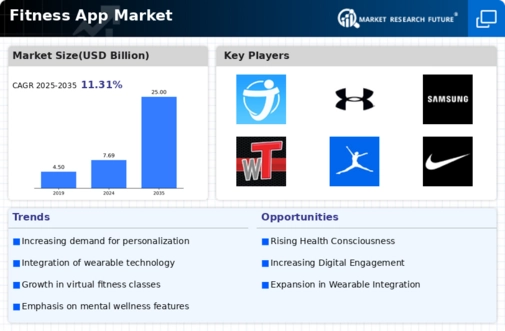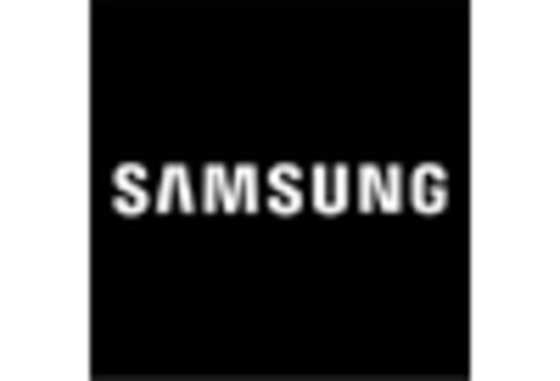Workout Tracker
Nutrition Tracker
Wellness Coach
Activity Tracker
Adults
Teenagers
Seniors
Children
iOS
Android
Web-based
Free
Freemium
Paid
North America
Europe
South America
Asia Pacific
Middle East and Africa
North America Outlook (USD Billion, 2019-2035)
North America Fitness App Market by App Type
Workout Tracker
Nutrition Tracker
Wellness Coach
Activity Tracker
North America Fitness App Market by User Demographics Type
Adults
Teenagers
Seniors
Children
North America Fitness App Market by Platform Type
iOS
Android
Web-based
North America Fitness App Market by Subscription Model Type
Free
Freemium
Paid
North America Fitness App Market by Regional Type
US
Canada
US Outlook (USD Billion, 2019-2035)
US Fitness App Market by App Type
Workout Tracker
Nutrition Tracker
Wellness Coach
Activity Tracker
US Fitness App Market by User Demographics Type
Adults
Teenagers
Seniors
Children
US Fitness App Market by Platform Type
iOS
Android
Web-based
US Fitness App Market by Subscription Model Type
Free
Freemium
Paid
CANADA Outlook (USD Billion, 2019-2035)
CANADA Fitness App Market by App Type
Workout Tracker
Nutrition Tracker
Wellness Coach
Activity Tracker
CANADA Fitness App Market by User Demographics Type
Adults
Teenagers
Seniors
Children
CANADA Fitness App Market by Platform Type
iOS
Android
Web-based
CANADA Fitness App Market by Subscription Model Type
Free
Freemium
Paid
Europe Outlook (USD Billion, 2019-2035)
Europe Fitness App Market by App Type
Workout Tracker
Nutrition Tracker
Wellness Coach
Activity Tracker
Europe Fitness App Market by User Demographics Type
Adults
Teenagers
Seniors
Children
Europe Fitness App Market by Platform Type
iOS
Android
Web-based
Europe Fitness App Market by Subscription Model Type
Free
Freemium
Paid
Europe Fitness App Market by Regional Type
Germany
UK
France
Russia
Italy
Spain
Rest of Europe
GERMANY Outlook (USD Billion, 2019-2035)
GERMANY Fitness App Market by App Type
Workout Tracker
Nutrition Tracker
Wellness Coach
Activity Tracker
GERMANY Fitness App Market by User Demographics Type
Adults
Teenagers
Seniors
Children
GERMANY Fitness App Market by Platform Type
iOS
Android
Web-based
GERMANY Fitness App Market by Subscription Model Type
Free
Freemium
Paid
UK Outlook (USD Billion, 2019-2035)
UK Fitness App Market by App Type
Workout Tracker
Nutrition Tracker
Wellness Coach
Activity Tracker
UK Fitness App Market by User Demographics Type
Adults
Teenagers
Seniors
Children
UK Fitness App Market by Platform Type
iOS
Android
Web-based
UK Fitness App Market by Subscription Model Type
Free
Freemium
Paid
FRANCE Outlook (USD Billion, 2019-2035)
FRANCE Fitness App Market by App Type
Workout Tracker
Nutrition Tracker
Wellness Coach
Activity Tracker
FRANCE Fitness App Market by User Demographics Type
Adults
Teenagers
Seniors
Children
FRANCE Fitness App Market by Platform Type
iOS
Android
Web-based
FRANCE Fitness App Market by Subscription Model Type
Free
Freemium
Paid
RUSSIA Outlook (USD Billion, 2019-2035)
RUSSIA Fitness App Market by App Type
Workout Tracker
Nutrition Tracker
Wellness Coach
Activity Tracker
RUSSIA Fitness App Market by User Demographics Type
Adults
Teenagers
Seniors
Children
RUSSIA Fitness App Market by Platform Type
iOS
Android
Web-based
RUSSIA Fitness App Market by Subscription Model Type
Free
Freemium
Paid
ITALY Outlook (USD Billion, 2019-2035)
ITALY Fitness App Market by App Type
Workout Tracker
Nutrition Tracker
Wellness Coach
Activity Tracker
ITALY Fitness App Market by User Demographics Type
Adults
Teenagers
Seniors
Children
ITALY Fitness App Market by Platform Type
iOS
Android
Web-based
ITALY Fitness App Market by Subscription Model Type
Free
Freemium
Paid
SPAIN Outlook (USD Billion, 2019-2035)
SPAIN Fitness App Market by App Type
Workout Tracker
Nutrition Tracker
Wellness Coach
Activity Tracker
SPAIN Fitness App Market by User Demographics Type
Adults
Teenagers
Seniors
Children
SPAIN Fitness App Market by Platform Type
iOS
Android
Web-based
SPAIN Fitness App Market by Subscription Model Type
Free
Freemium
Paid
REST OF EUROPE Outlook (USD Billion, 2019-2035)
REST OF EUROPE Fitness App Market by App Type
Workout Tracker
Nutrition Tracker
Wellness Coach
Activity Tracker
REST OF EUROPE Fitness App Market by User Demographics Type
Adults
Teenagers
Seniors
Children
REST OF EUROPE Fitness App Market by Platform Type
iOS
Android
Web-based
REST OF EUROPE Fitness App Market by Subscription Model Type
Free
Freemium
Paid
APAC Outlook (USD Billion, 2019-2035)
APAC Fitness App Market by App Type
Workout Tracker
Nutrition Tracker
Wellness Coach
Activity Tracker
APAC Fitness App Market by User Demographics Type
Adults
Teenagers
Seniors
Children
APAC Fitness App Market by Platform Type
iOS
Android
Web-based
APAC Fitness App Market by Subscription Model Type
Free
Freemium
Paid
APAC Fitness App Market by Regional Type
China
India
Japan
South Korea
Malaysia
Thailand
Indonesia
Rest of APAC
CHINA Outlook (USD Billion, 2019-2035)
CHINA Fitness App Market by App Type
Workout Tracker
Nutrition Tracker
Wellness Coach
Activity Tracker
CHINA Fitness App Market by User Demographics Type
Adults
Teenagers
Seniors
Children
CHINA Fitness App Market by Platform Type
iOS
Android
Web-based
CHINA Fitness App Market by Subscription Model Type
Free
Freemium
Paid
INDIA Outlook (USD Billion, 2019-2035)
INDIA Fitness App Market by App Type
Workout Tracker
Nutrition Tracker
Wellness Coach
Activity Tracker
INDIA Fitness App Market by User Demographics Type
Adults
Teenagers
Seniors
Children
INDIA Fitness App Market by Platform Type
iOS
Android
Web-based
INDIA Fitness App Market by Subscription Model Type
Free
Freemium
Paid
JAPAN Outlook (USD Billion, 2019-2035)
JAPAN Fitness App Market by App Type
Workout Tracker
Nutrition Tracker
Wellness Coach
Activity Tracker
JAPAN Fitness App Market by User Demographics Type
Adults
Teenagers
Seniors
Children
JAPAN Fitness App Market by Platform Type
iOS
Android
Web-based
JAPAN Fitness App Market by Subscription Model Type
Free
Freemium
Paid
SOUTH KOREA Outlook (USD Billion, 2019-2035)
SOUTH KOREA Fitness App Market by App Type
Workout Tracker
Nutrition Tracker
Wellness Coach
Activity Tracker
SOUTH KOREA Fitness App Market by User Demographics Type
Adults
Teenagers
Seniors
Children
SOUTH KOREA Fitness App Market by Platform Type
iOS
Android
Web-based
SOUTH KOREA Fitness App Market by Subscription Model Type
Free
Freemium
Paid
MALAYSIA Outlook (USD Billion, 2019-2035)
MALAYSIA Fitness App Market by App Type
Workout Tracker
Nutrition Tracker
Wellness Coach
Activity Tracker
MALAYSIA Fitness App Market by User Demographics Type
Adults
Teenagers
Seniors
Children
MALAYSIA Fitness App Market by Platform Type
iOS
Android
Web-based
MALAYSIA Fitness App Market by Subscription Model Type
Free
Freemium
Paid
THAILAND Outlook (USD Billion, 2019-2035)
THAILAND Fitness App Market by App Type
Workout Tracker
Nutrition Tracker
Wellness Coach
Activity Tracker
THAILAND Fitness App Market by User Demographics Type
Adults
Teenagers
Seniors
Children
THAILAND Fitness App Market by Platform Type
iOS
Android
Web-based
THAILAND Fitness App Market by Subscription Model Type
Free
Freemium
Paid
INDONESIA Outlook (USD Billion, 2019-2035)
INDONESIA Fitness App Market by App Type
Workout Tracker
Nutrition Tracker
Wellness Coach
Activity Tracker
INDONESIA Fitness App Market by User Demographics Type
Adults
Teenagers
Seniors
Children
INDONESIA Fitness App Market by Platform Type
iOS
Android
Web-based
INDONESIA Fitness App Market by Subscription Model Type
Free
Freemium
Paid
REST OF APAC Outlook (USD Billion, 2019-2035)
REST OF APAC Fitness App Market by App Type
Workout Tracker
Nutrition Tracker
Wellness Coach
Activity Tracker
REST OF APAC Fitness App Market by User Demographics Type
Adults
Teenagers
Seniors
Children
REST OF APAC Fitness App Market by Platform Type
iOS
Android
Web-based
REST OF APAC Fitness App Market by Subscription Model Type
Free
Freemium
Paid
South America Outlook (USD Billion, 2019-2035)
South America Fitness App Market by App Type
Workout Tracker
Nutrition Tracker
Wellness Coach
Activity Tracker
South America Fitness App Market by User Demographics Type
Adults
Teenagers
Seniors
Children
South America Fitness App Market by Platform Type
iOS
Android
Web-based
South America Fitness App Market by Subscription Model Type
Free
Freemium
Paid
South America Fitness App Market by Regional Type
Brazil
Mexico
Argentina
Rest of South America
BRAZIL Outlook (USD Billion, 2019-2035)
BRAZIL Fitness App Market by App Type
Workout Tracker
Nutrition Tracker
Wellness Coach
Activity Tracker
BRAZIL Fitness App Market by User Demographics Type
Adults
Teenagers
Seniors
Children
BRAZIL Fitness App Market by Platform Type
iOS
Android
Web-based
BRAZIL Fitness App Market by Subscription Model Type
Free
Freemium
Paid
MEXICO Outlook (USD Billion, 2019-2035)
MEXICO Fitness App Market by App Type
Workout Tracker
Nutrition Tracker
Wellness Coach
Activity Tracker
MEXICO Fitness App Market by User Demographics Type
Adults
Teenagers
Seniors
Children
MEXICO Fitness App Market by Platform Type
iOS
Android
Web-based
MEXICO Fitness App Market by Subscription Model Type
Free
Freemium
Paid
ARGENTINA Outlook (USD Billion, 2019-2035)
ARGENTINA Fitness App Market by App Type
Workout Tracker
Nutrition Tracker
Wellness Coach
Activity Tracker
ARGENTINA Fitness App Market by User Demographics Type
Adults
Teenagers
Seniors
Children
ARGENTINA Fitness App Market by Platform Type
iOS
Android
Web-based
ARGENTINA Fitness App Market by Subscription Model Type
Free
Freemium
Paid
REST OF SOUTH AMERICA Outlook (USD Billion, 2019-2035)
REST OF SOUTH AMERICA Fitness App Market by App Type
Workout Tracker
Nutrition Tracker
Wellness Coach
Activity Tracker
REST OF SOUTH AMERICA Fitness App Market by User Demographics Type
Adults
Teenagers
Seniors
Children
REST OF SOUTH AMERICA Fitness App Market by Platform Type
iOS
Android
Web-based
REST OF SOUTH AMERICA Fitness App Market by Subscription Model Type
Free
Freemium
Paid
MEA Outlook (USD Billion, 2019-2035)
MEA Fitness App Market by App Type
Workout Tracker
Nutrition Tracker
Wellness Coach
Activity Tracker
MEA Fitness App Market by User Demographics Type
Adults
Teenagers
Seniors
Children
MEA Fitness App Market by Platform Type
iOS
Android
Web-based
MEA Fitness App Market by Subscription Model Type
Free
Freemium
Paid
MEA Fitness App Market by Regional Type
GCC Countries
South Africa
Rest of MEA
GCC COUNTRIES Outlook (USD Billion, 2019-2035)
GCC COUNTRIES Fitness App Market by App Type
Workout Tracker
Nutrition Tracker
Wellness Coach
Activity Tracker
GCC COUNTRIES Fitness App Market by User Demographics Type
Adults
Teenagers
Seniors
Children
GCC COUNTRIES Fitness App Market by Platform Type
iOS
Android
Web-based
GCC COUNTRIES Fitness App Market by Subscription Model Type
Free
Freemium
Paid
SOUTH AFRICA Outlook (USD Billion, 2019-2035)
SOUTH AFRICA Fitness App Market by App Type
Workout Tracker
Nutrition Tracker
Wellness Coach
Activity Tracker
SOUTH AFRICA Fitness App Market by User Demographics Type
Adults
Teenagers
Seniors
Children
SOUTH AFRICA Fitness App Market by Platform Type
iOS
Android
Web-based
SOUTH AFRICA Fitness App Market by Subscription Model Type
Free
Freemium
Paid
REST OF MEA Outlook (USD Billion, 2019-2035)
REST OF MEA Fitness App Market by App Type
Workout Tracker
Nutrition Tracker
Wellness Coach
Activity Tracker
REST OF MEA Fitness App Market by User Demographics Type
Adults
Teenagers
Seniors
Children
REST OF MEA Fitness App Market by Platform Type
iOS
Android
Web-based
REST OF MEA Fitness App Market by Subscription Model Type
Free
Freemium
Paid









Leave a Comment